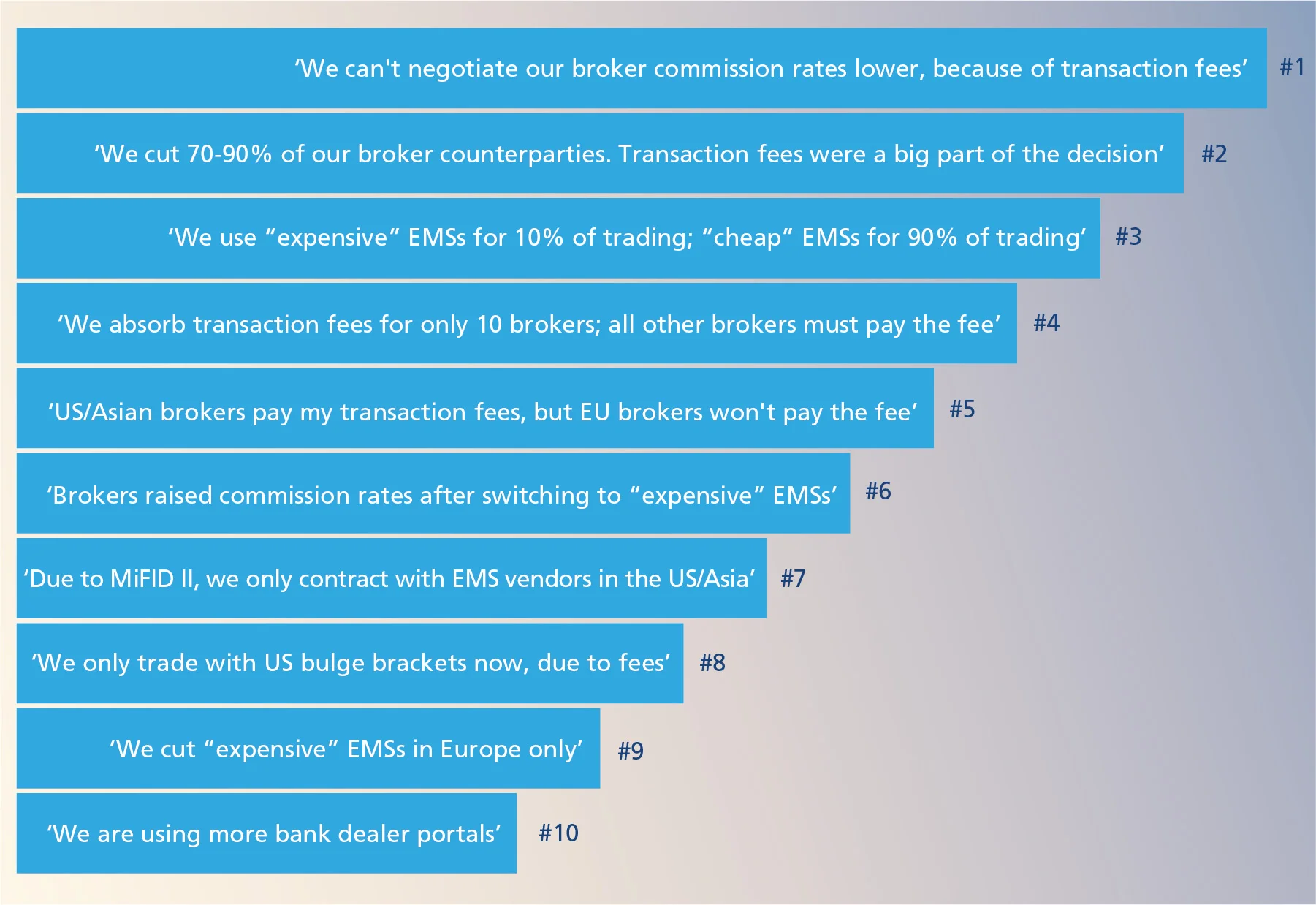Neovest fine stokes the EMS transaction fee debate

The SEC’s fine for J.P. Morgan’s Neovest could signal a shift in how the industry views contentious EMS transaction fees. Chartis’ research shows that, as regulatory pressure mounts, investment managers and vendors may have to rethink their transaction-fee strategies.
EMS transaction fees: benefit or bane?
On 28 June the Securities and Exchange Commission (SEC) announced that it had levied a fine on Neovest, a division of JPMorgan Chase, for operating as an unregistered broker-dealer. According to the SEC, Neovest has agreed to pay $2.75 million, in what constitutes the first such charge against a provider of an order and execution management system (EMS).
Regulators are working to improve transparency in the financial services sector and encourage intermediaries to put their investor clients’ interests ahead of their own. But Chartis believes that about half of EMS vendors charge transaction fees[1], which are typically kept secret. These fees are akin to payment for order flow (PFOF) schemes, in which EMS vendors’ revenues are driven by their clients’ trading volumes, rather than a flat fee for using EMS software.
Transaction fees can be a windfall for those EMS vendors that charge them to the sell-side, and a point of contention for EMS vendors that do not charge them at all. Most of the media articles[2] about EMS transaction fees point to buy- and sell-side institutions that object to the practice. In reality, however, many buy- and sell-side firms are in favor of EMS transaction fees, as they often work in their best interest:
- Buy-side firms: transaction fees can help cut costs, as brokers subsidize EMS fees.
- Sell-side firms: transaction fees, as a form of PFOF, can help them gain valuable order flow.
- EMS vendors: transaction fees can help fund growth.
In fact, according to Chartis’ research[3], EMS vendor transaction fees can easily exceed $1 million for 10 broker connections, and up to $10 million for 100 broker connections, per year, per buy-side client. (Buy-side EMS clients typically require about 10 to 100 broker connections, depending on their regional or multi-asset coverage.) In some cases, transaction fee caps can be negotiated, but there is little or no transparency in this, as EMS vendor-broker fee agreements are typically hidden behind non-disclosure agreements (NDAs).
In terms of commission rate sharing, the lower the broker commission rate the greater the percentage share of commission revenue that goes to EMS vendors in the form of transaction fees. According to our research, brokers often share about 10-20% of commission revenue with EMS vendors for high-commission rate, high-touch order flow, and about 60-70% of commission revenue for low-commission rate, low-touch algorithmic-trading order flow. The trend in broker trading services is toward increasing use of low-touch algorithmic trading, which has grown from about 30% of total equity order flow in 2018 to more than 60% currently.
Regulatory pressure
Regulators are working to bring transparency to the financial services sector, in part by encouraging investment managers to put their investor clients’ interests ahead of their own. Most recently, PFOF schemes have come under regulatory scrutiny due to their lack of transparency.
Article 24(8) of Markets in Financial Instruments Directive II (MiFID II) prohibits investment managers from accepting benefits or inducements (EMS fee subsidization, in this case) paid by any third party (sell-side brokers, in this case)[4]. FIX connectivity fees and other nominal transaction reporting service fees are generally accepted, as they do not influence best execution.
Transaction fees, by contrast, can and do affect best execution, by making access prohibitively expensive while driving order flow to a small number of the larger, bulge-bracket brokers that are more likely to be able to absorb the transaction fees. As a result, investment managers, and their investor clients, end up paying more money to access fewer sources of liquidity. Transaction fees violate several MiFID II stipulations, including:
- Client’s best interest: transaction fees are not in investor clients’ best interest.
- Inducements: sell-side firms are prohibited from paying the buy-side’s EMS transaction fees.
- Conflicts of interest: buy-side firms must prevent conflicts (brokers paying their EMS fees).
- Payment for order flow: EMS vendors must not sell their client order flow to brokers in exchange for payment of their EMS fees.
- Unbundling: sell-side firms must separate EMS transaction fees from trading commissions.
Addressing the challenge: regulatory arbitrage
The spirit of the regulation is to encourage investment managers to be more transparent, and to place clients’ interests ahead of their own. But no regulatory rules directly address transaction fees, per se. While MiFID II prohibits investment managers from accepting sell-side broker benefits, or inducements, it does not mention EMS transaction fees specifically. US and Asian regulations are also silent on EMS transaction fees. In the UK, the Financial Conduct Authority’s (FCA’s) policy statement PS17/14 appears to allow transaction fees, by stating that transaction reporting services can be bundled with commissions provided that they are a minor benefit, and that doing so does not influence best execution[5]. But this relates to nominal FIX connectivity fees, not the more significant EMS transaction fees.
Most investment managers believe in the spirit of regulation around transparency. But they also find that transaction fees, and brokers’ subsidization of their EMS expenses, are in their best interest, especially as cost-cutting pressures intensify. Many investment managers choose to plead ignorance when it comes to transaction fees, and they are well supported in doing so, given that most EMS transaction-fee agreements with brokers are kept secret, hidden from buy-side clients’ view, and guarded by NDAs.
Another approach taken by investment managers seeking to ‘square the circle’ around transaction fees is to engage in regulatory arbitrage with EMS vendors and brokers. They are well supported in this too, given that EMS transaction fees are not specifically mentioned in the regulations.
A best-fit approach
According to our interviews with asset managers and EMS vendors (see Figure 1), the buy-side is engaged in a variety of regulatory arbitrage strategies designed to achieve a best-fit hybrid approach to working around transaction fee-related transparency regulation.
This can be summarized into six main approaches:
- Cut brokers that will not absorb transaction fees.
- Absorb transaction fees for a few brokers, but not all.
- Allow some brokers to raise commission rates to pay fees, but not all.
- Contract with EMS vendors in the most favorable regulatory jurisdictions.
- Use multiple EMS vendors (some that charge transaction fees; some that don’t).
- Use more single-dealer bank portals to trade.
Figure 1: Ranking of buy-side firms’ views on transaction fees and regulatory arbitrage strategies

Source: Chartis Research, based on interviews with buy-side firms and EMS vendors
For further analysis of EMS transaction fees and the wider EMS market landscape, see the Chartis report Execution Management Systems, 2021: Market and Vendor Landscape.
Further reading
Execution Management Systems, 2021: Market and Vendor Landscape (Chartis, 2021)
Buy-side firms reject EMS brokerage charges (Risk.net)
[1] Transaction fees should not be confused with connectivity fees, which are nominal fixed monthly Financial Information eXchange (FIX) network charges.
[2] See, for example, https://www.waterstechnology.com/trading-tools/7652856/buy-side-firms-reject-ems-brokerage-charges
[3] In 2020/21 we interviewed representatives of 15 buy-side firms, including head traders, trader specialists, technology analysts and trading analysts. Of the firms we spoke to, 33% were large (with more than $100 billion in assets under management [AUM]), 47% medium-sized ($1 billion to $100 billion AUM), and 20% small (less than $1 billion AUM).
Points of View are short articles in which members of the Chartis team express their opinions on relevant topics in the risk technology marketplace. Chartis is a trading name of Infopro Digital Services Limited, whose branded publications consist of the opinions of its research analysts and should not be construed as advice.
If you have any comments or queries on Chartis Points of View, you can email the individual author, or email Chartis at info@chartis-research.com.
Only users who have a paid subscription or are part of a corporate subscription are able to print or copy content.
To access these options, along with all other subscription benefits, please contact info@risk.net or view our subscription options here: http://subscriptions.risk.net/subscribe
You are currently unable to print this content. Please contact info@chartis-research.com to find out more.
You are currently unable to copy this content. Please contact info@chartis-research.com to find out more.
Copyright Infopro Digital Limited. All rights reserved.
As outlined in our terms and conditions, https://www.infopro-digital.com/terms-and-conditions/subscriptions/ (point 2.4), printing is limited to a single copy.
If you would like to purchase additional rights please email info@chartis-research.com
Copyright Infopro Digital Limited. All rights reserved.
You may share this content using our article tools. As outlined in our terms and conditions, https://www.infopro-digital.com/terms-and-conditions/subscriptions/ (clause 2.4), an Authorised User may only make one copy of the materials for their own personal use. You must also comply with the restrictions in clause 2.5.
If you would like to purchase additional rights please email info@chartis-research.com




